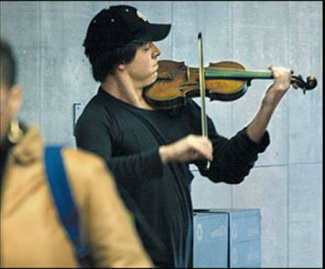 Violinist Joshua Bell performing in a subway station. Tags: art/music, class, goffman, methodology/statistics, theory, defining the situation, pierre bourdieu, social experiment, taste, subtitles/CC, 00 to 05 mins Year: 2007 Length: 2:52 Access: YouTube Summary: This video footage depicts a young man playing a violin in a Washington, DC Metro station during the heart of the morning rush hour. Unbeknownst to passersby, the musician is the world renowned Joshua Bell, playing one of the most difficult pieces ever written, on a violin worth $3.5 million dollars. In total, Bell played for about 45 minutes to about 1,100 people moving through the station. During this time, only a handful stopped to listen; he collected $32. Organized by the Washington Post, this social experiment was designed to broach questions around perception, beauty, and priorities; however, it can also be used to teach sociological concepts, such as Erving Goffman's theory of defining the situation and Pierre Bourdieu's theory of taste. Goffman argues that when individuals encounter one another, they (consciously or not) seek out information about the other so as to define the nature of the interaction. Morning commuters use the information around them to define the interaction between themselves and the violinist, including the fact that the musician is playing in a subway station, wearing everyday street clothes, standing beside an open violin case occupied by loose bills and change. Despite Bell's talent and professional status, given this information, the majority of commuters define the situation as an amateur musician playing for money, and they ignore him. Had the situation been defined with a sign that identified the world famous violinist playing an impromptu public concert, presumably more commuters would have stopped to listen. This latter point also speaks to Bourdieu's theory of taste, in which Bourdieu rejects a pure or genuine conception of aesthetics and instead argues that "good taste" is simply a reflection of the taste of the ruling class, demarcated by ruling class signifiers. Given that Bell is in a non-elite space, wearing non-elite clothing, playing for a non-elite audience, commuters are unable to recognize the highly skilled nature of the art. This demonstrates how good taste can be understood as a social (and Bourdieu would say classed) phenomenon, rather than an objective truth. This clip is one of several featured on The Sociological Cinema that illustrates social experiments, including experiments on racial bias, the Milgram experiment, and breaching experiments at Grand Central Station and on a college campus. Submitted By: Valerie Chepp
4 Comments
manjeet chaturvedi
4/21/2013 01:53:10 am
This experiment brings out the fact that a presentation in public sphere receives popular common response on the grounds of 'uncommon' or 'celebrity' status of the presenter more than its other appeal of what was presented.
Reply
David Kirschner
10/26/2018 02:48:17 pm
Just to update the video here: https://www.youtube.com/watch?v=hnOPu0_YWhw
Reply
Manuel Franco
7/30/2023 12:19:38 pm
I just want to say Thank You to everyone who supported me through the years. My name is Manuel Franco, New Berlin, Wisconsin. My story of how I won the Powerball lottery of $768.4M is a bit of a tale. I have been playing Powerball tickets for 6 years now since I turned 18. I bought my first ticket on my 18 birthday. I was feeling very lucky that day because I had contacted Dr. Odunga Michael to help me with the winning Powerball numbers. I really had that great great feeling that I looked at the camera wanting to wink at it. I only did a tiny part of it and trusted him. He gave me the numbers after I played a couple other tickets along with it for $10. I checked my ticket after the winnings came online and saw the numbers were correct including the Power play. I screamed for about 10 minutes because it felt like a dream. I had won $768.4M. You can check my winning testimony with the lottery officials just with my name search. Thank you Dr Odunga. Well, his email is [email protected] and you can also call or Whats-app him at +2348167159012 so you guys can contact him
Reply
mark hold
7/8/2024 08:25:30 am
Herbal Penis Enlargement product is 100% guaranteed to Enlarge and get a better ERECTION, the reason why most people are finding it difficult to enlarge Penis is that they believe in medical reports, drugs and medical treatment which is not helpful for Penis Enlargement. Natural roots/herbs are the best remedies which can easily Enlarge your Penis permanently Contact Dr MOSES BUBA via Email: [email protected] or via WhatsApp: +2349060529305. for Natural root and herbal remedies put together to help Enlarge manhood and Erect healthily. I also learn that Dr MOSES BUBA also can cure other types of diseases, HEPATITIS B,DIABETICS,CANCER,HPV,LOW SPERM CAM, HIV/STDS, FIBROSIS LOST OF WEIGHT, BREAST ENLARGEMENT, HIPS and BUMS ENLARGEMENT etc .
Reply
Leave a Reply. |
Tags
All
.
Got any videos?
Are you finding useful videos for your classes? Do you have good videos you use in your own classes? Please consider submitting your videos here and helping us build our database!
|
 RSS Feed
RSS Feed
